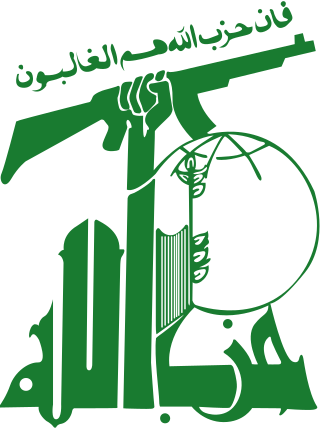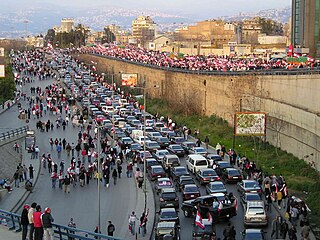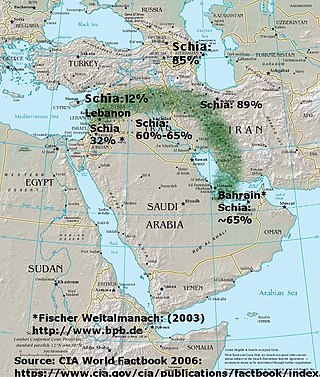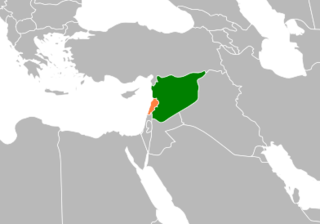
Hezbollah is a Lebanese Shia Islamist political party and militant group, led since 1992 by its Secretary-General Hassan Nasrallah. Hezbollah's paramilitary wing is the Jihad Council, and its political wing is the Loyalty to the Resistance Bloc party in the Lebanese Parliament.

The Lebanese Civil War was a multifaceted armed conflict that took place from 1975 to 1990. It resulted in an estimated 150,000 fatalities and also led to the exodus of almost one million people from Lebanon.

Rafic Bahaa El Deen al-Hariri, also known as Rafiq al-Hariri, was a Lebanese business tycoon and politician, who served as the Prime Minister of Lebanon from 1992 to 1998 and again from 2000 until he resigned on 20 October 2004, before his assassination in 2005.

Walid Kamal Jumblatt is a Lebanese politician who was the leader of the Progressive Socialist Party from 1977 until 2023. A Druze and former militia commander, Jumblatt led the Lebanese National Resistance Front and allied with the Amal Movement during the Lebanese Civil War. He worked closely with Suleiman Frangieh to oppose Amine Gemayel's rule as president in 1983. After the civil war, he initially supported Syria but later led an anti-Assad stance during the start of the Syrian Civil War. He is still active in politics, most recently leading his party, the Progressive Socialist Party (PSP) in the 2022 Lebanese general election.

The Syrian occupation of Lebanon began in 1976, during the Syrian intervention in the Lebanese Civil War, and ended on April 30, 2005, after the Cedar Revolution and several demonstrations in which most of the Lebanese people participated. The withdrawal agreement was signed by President Bashar al-Assad and Saad Hariri, son of Rafic Hariri, whose assassination triggered the series of events leading to the withdrawal.

Dahieh is a predominantly Shia Muslim suburb in the south of Beirut, in the Baabda District of Lebanon. It is composed of several towns and municipalities. It is a residential and commercial area with malls, stores and souks.

The Shia Crescent is the notionally crescent-shaped region of the Middle East where the majority population is Shia or where there is a strong Shia minority in the population.
After the death of Muhammad in 632, a group of Muslims, who would come to be known as the Sunnis, believed that Muhammad's successor as caliph of the Islamic community should be Abu Bakr, whereas a second group of Muslims, who would come to be known as the Shias, believed that his successor should have been Ali ibn Abi Talib. This dispute spread across various parts of the Muslim world, which eventually led to the Battle of Jamal and Battle of Siffin. Sectarianism based on this historic dispute intensified greatly after the Battle of Karbala, in which Husayn ibn Ali and some of his close partisans, including members and children of Muhammad's household, were killed by the ruling Umayyad Caliph Yazid I, and the outcry for revenge divided the early Islamic community, albeit disproportionately, into two groups, the Sunni and the Shia. This is known today as the Islamic schism.

Lebanon–Syria relations were officially established in October 2008 when Syrian President Bashar Al-Assad issued a decree to establish diplomatic relations with Lebanon for the first time since both countries gained independence from France in 1943 (Lebanon) and 1946 (Syria). Lebanon had traditionally been seen by Syria as part of Greater Syria. Following World War I, the League of Nations Mandate partitioned Ottoman Syria under French control, eventually leading to the creation of nation-states Lebanon and Syria.
The Axis of Resistance is an informal Iranian-led political and military coalition in West Asia and North Africa. It most notably includes the Syrian government, the Lebanese political party and militant group Hezbollah, the Yemeni political and military organization Ansar Allah, and a variety of Palestinian militant groups.

Mustafa Badreddine, also known as Mustafa Badr Al Din, Mustafa Amine Badreddine, Mustafa Youssef Badreddine, Sami Issa, and Elias Fouad Saab, was a military leader of Hezbollah and both the cousin and brother-in-law of Imad Mughniyah. He was nicknamed Dhu al-Fiqar referring to the legendary sword of Imam Ali. His death is seen as one of the biggest blows in the Hezbollah leadership.
On 19 October 2012, Wissam al-Hassan, a brigadier general of the Lebanese Internal Security Forces (ISF) and the head of its intelligence-oriented information branch, died along with several others killed by a car bomb in the Achrafieh district of Beirut. The killing of a senior figure closely linked with the anti-Assad camp in Lebanon led to immediate speculation that Syria, or its allies, were behind the attack in Beirut. Al-Hassan had also led the investigation that implicated Syria and its ally Hezbollah in the killing of the former prime minister Rafik Hariri.
Ahmad Al-Assir is a Lebanese former Sunni Imam of the Bilal Bin Rabah Mosque in Sidon. He is considered by some to be a Salafi.
On 15 August 2013, a car bomb exploded in Beirut, Lebanon killing 27 people and injuring over 200 people. The car bomb was intended for the stronghold of Hezbollah. It was reportedly the "worst explosion in south Beirut" since a 1985 truck bomb assassination attempt targeting top Shiite cleric Mohammed Hussein Fadlallah. The Islamist group Aisha Umm-al Mouemeneen, also known as Brigades of Aisha, were responsible for the explosion. In their statement the group accused Hezbollah of being Iranian agents and threatened more attacks. "This is the second time that we decide the time and place of the battle ... And you will see more, God willing," However Interior Minister Marwan Charbel and other politicians blamed Israel for the attack.
The assassination of Mohamad Chatah occurred on 27 December 2013 when a car bomb targeting a convoy detonated in Beirut Central District killing Chatah, his bodyguard, and four others. Chatah had previously served as Lebanon's finance minister and ambassador to the United States and was known as a leading critic of Hezbollah and the Assad regime among the country's political elite. Described as a political assassination, the killing was widely seen as a message to Lebanon's March 14 movement.
From its inception, the Syrian Civil War has produced and inspired a great deal of strife and unrest in the nation of Lebanon. Prior to the Battle of Arsal in August 2014, the Lebanese Army has tried to keep out of it and the violence has been mostly between various factions within the country and overt Syrian involvement has been limited to airstrikes and occasional accidental incursions.

Hezbollah involvement in the Syrian Civil War has been substantial since the beginning of armed insurgency phase of the Syrian Civil War in 2011, and evolved into active support for Ba'athist government forces and troop deployment from 2012 onwards. By 2014, Hezbollah was deployed across Syria. Hezbollah has also been very active in preventing Al-Nusra Front and Islamic State penetration into Lebanon, being one of the most active forces in the Syrian Civil War spillover in Lebanon.
Lebanon's role in the Syrian Civil War has been limited, compared to the role of other regional and international actors. While the Lebanese Republic has not been officially involved in the conflict, it has been greatly affected by it and some Lebanese factors have taken an active role in the Syrian War and its spillover into Lebanon.

The Baqir Brigade, named after Shia Imam Muhammad al-Baqir, is a Syrian loyalist militia originating in the Aleppo Governorate that fights in the Syrian Civil War. One of the most prominent and largest pro-government militias from the Aleppo area and part of the "Local Defence Forces" network, the Baqir Brigade mostly consists of tribesmen from the al-Baggara tribe that traditionally supported the rule of the al-Assad family despite being mostly Sunni Muslim. Though the militia's fighters thus come from a largely Sunni background, many of them have converted to or are at least strongly influenced by Shia Islam. Indeed, the Baqir Brigade has been noted for its strong connections to the Lebanese Hezbollah, Iran, and various Iraqi Shia militias, and is thus generally considered to be a Shia or "Shi'ified" fighting force.










